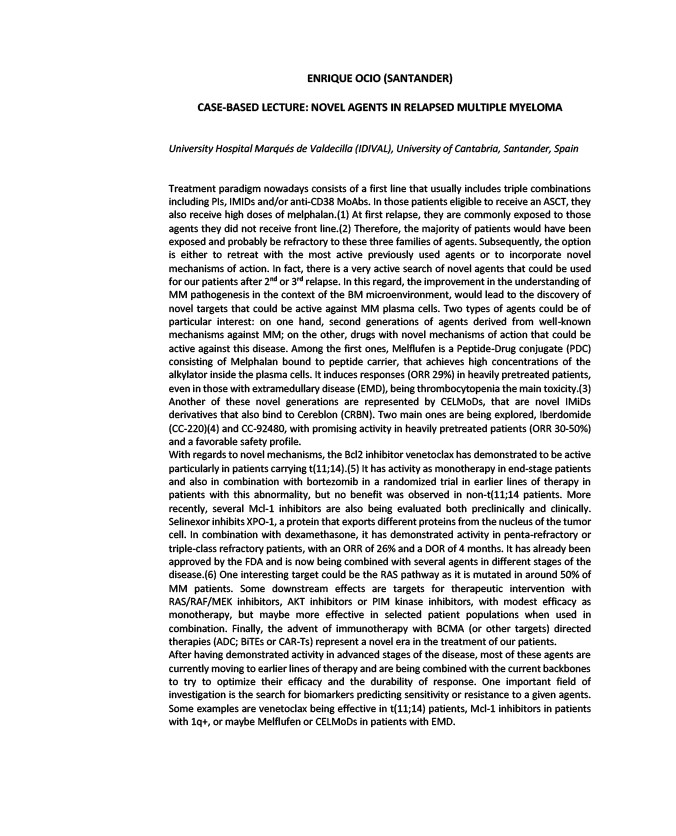
ENRIQUE OCIO (SANTANDER)
CASE-BASED LECTURE: NOVEL AGENTS IN RELAPSED MULTIPLE MYELOMA
University Hospital Marqués de Valdecilla (IDIVAL), University of Cantabria, Santander, Spain
Treatment paradigm nowadays consists of a first line that usually includes triple combinations
including PIs, IMIDs and/or anti-CD38 MoAbs. In those patients eligible to receive an ASCT, they
also receive high doses of melphalan.(1) At first relapse, they are commonly exposed to those
agents they did not receive front line.(2) Therefore, the majority of patients would have been
exposed and probably be refractory to these three families of agents. Subsequently, the option
is either to retreat with the most active previously used agents or to incorporate novel
mechanisms of action. In fact, there is a very active search of novel agents that could be used
for our patients after 2nd or 3rd relapse. In this regard, the improvement in the understanding of
MM pathogenesis in the context of the BM microenvironment, would lead to the discovery of
novel targets that could be active against MM plasma cells. Two types of agents could be of
particular interest: on one hand, second generations of agents derived from well-known
mechanisms against MM; on the other, drugs with novel mechanisms of action that could be
active against this disease. Among the first ones, Melflufen is a Peptide-Drug conjugate (PDC)
consisting of Melphalan bound to peptide carrier, that achieves high concentrations of the
alkylator inside the plasma cells. It induces responses (ORR 29%) in heavily pretreated patients,
even in those with extramedullary disease (EMD), being thrombocytopenia the main toxicity.(3)
Another of these novel generations are represented by CELMoDs, that are novel IMiDs
derivatives that also bind to Cereblon (CRBN). Two main ones are being explored, Iberdomide
(CC-220)(4) and CC-92480, with promising activity in heavily pretreated patients (ORR 30-50%)
and a favorable safety profile.
With regards to novel mechanisms, the Bcl2 inhibitor venetoclax has demonstrated to be active
particularly in patients carrying t(11;14).(5) It has activity as monotherapy in end-stage patients
and also in combination with bortezomib in a randomized trial in earlier lines of therapy in
patients with this abnormality, but no benefit was observed in non-t(11;14 patients. More
recently, several Mcl-1 inhibitors are also being evaluated both preclinically and clinically.
Selinexor inhibits XPO-1, a protein that exports different proteins from the nucleus of the tumor
cell. In combination with dexamethasone, it has demonstrated activity in penta-refractory or
triple-class refractory patients, with an ORR of 26% and a DOR of 4 months. It has already been
approved by the FDA and is now being combined with several agents in different stages of the
disease.(6) One interesting target could be the RAS pathway as it is mutated in around 50% of
MM patients. Some downstream effects are targets for therapeutic intervention with
RAS/RAF/MEK inhibitors, AKT inhibitors or PIM kinase inhibitors, with modest efficacy as
monotherapy, but maybe more effective in selected patient populations when used in
combination. Finally, the advent of immunotherapy with BCMA (or other targets) directed
therapies (ADC; BiTEs or CAR-Ts) represent a novel era in the treatment of our patients.
After having demonstrated activity in advanced stages of the disease, most of these agents are
currently moving to earlier lines of therapy and are being combined with the current backbones
to try to optimize their efficacy and the durability of response. One important field of
investigation is the search for biomarkers predicting sensitivity or resistance to a given agents.
Some examples are venetoclax being effective in t(11;14) patients, Mcl-1 inhibitors in patients
with 1q+, or maybe Melflufen or CELMoDs in patients with EMD.